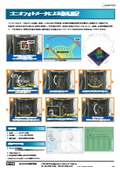We offer a standard measurement menu for measuring the spectral transmittance and reflectance of materials, as well as the scattering characteristics of transmittance and reflectance.
"Spectral transmittance and reflectance measurement using a UV-visible near-infrared spectrophotometer" Covers the measurement range from ultraviolet-visible to near-infrared, analyzing the spectral characteristics of physical properties. ● Measurement application examples Measurement of transmittance, reflectance, and optical properties of products using optical components made of glass or plastic materials. "Scattering measurement using a goniophotometer" Measures the optical properties of materials such as films (transmission scattering measurement, reflection scattering measurement) by automatically rotating the detector while illuminating with various lights according to the purpose. ● Measurement application examples - Measurement of angular variation in transmittance and reflectance characteristics of films, glass substrates, etc. - Measurement of BRDF and BTDF.
Inquire About This Product
basic information
"Spectral transmittance and reflectance measurement using a UV-visible near-infrared analysis photometer" ● Measurement Items 1. Direct transmittance measurement 2. Direct reflectance measurement (incident and reflection angles of 5 to 70 degrees) 3. Diffuse reflectance measurement (direct transmittance + diffuse transmittance components) 4. Diffuse transmittance measurement (direct reflectance + diffuse reflectance components) ● Measurement Specifications Measurement wavelength range Direct transmittance measurement: 190nm - 3300nm (direct light reception) Direct reflectance measurement: 250nm - 2500nm (absolute reflectance measurement, without polarizer) Diffuse transmittance/reflectance measurement: 240nm - 2600nm (integrating sphere) ● Measurement interval (standard): 2nm ● Compatible samples and sizes ・Flat plates ・Minimum size: 20mm×30mm to 30mm×40mm (integrating sphere) ・Maximum size: recommended to be 100mm square or smaller ・For sizes larger than the above, please inquire "Scattering measurement using a goniophotometer" ● Measurement wavelength range ・400nm - 800nm (using a halogen light source) ・Spectral analysis using bandpass filters ● Recommended sample shape and size ・Flat plates ・If 60mm square or smaller, must be larger than a circle with a diameter of 43mm ・Thickness up to about 5mm ・For sizes smaller/larger than the above, please inquire
Price information
Prices vary depending on the content, so please contact us for more information.
Delivery Time
Applications/Examples of results
"Spectrophotometric measurement of spectral transmittance and reflectance using a UV-visible near-infrared analyzer" - Measurement of transmittance for lenses and glass - Measurement of reflectance for other materials "Goniophotometer" - Measurement of angular variation in transmittance and reflectance characteristics of films, glass substrates, etc. - Measurement of the degree of diffusion of diffusing substrates - Measurement of BRDF and BTDF - Others
Detailed information
-

It covers the range from ultraviolet-visible to near-infrared and mainly measures the spectra of solid materials such as glass and plastic.
-

A goniophotometer is a device that measures the light scattering characteristics of transmission and reflection of materials such as glass substrates, metals, and films. By using a standard white board and performing value calibration, the BRDF of the sample can be determined.
catalog(1)
Download All CatalogsCompany information
"Contributing to Society through Light Simulation" Our representative director, Ritsuo Suzuki, has been developing evaluation software for imaging optical systems such as eyeglass real image simulators and digital cameras, as well as image processing software for interferometers, based on ray tracing technology since the early 2000s when he joined our parent company, Best Media Inc. He has supported various companies through these developments. Building on the technology cultivated there, we developed and marketed "Lighting Simulator CAD" and have provided various optical services. In October 2021, to enhance branding in the optical industry and attract specialized talent, we split from Best Media Inc. and established Camerium Inc. "Camerium" is a coined term derived from "Microscopium" and "Telescopium," symbolizing our aspiration to shine in the optical industry, akin to the "Camera" constellation.



